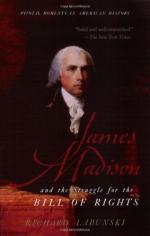|
This section contains 11,145 words (approx. 38 pages at 300 words per page) |

|
SOURCE: Draper, Theodore. “Hume & Madison: The Secrets of Federalist Paper No. 10,” Encounter 58, no. 2 (February 1982): 34-47.
In the following essay, Draper discusses Madison's debt to David Hume in the development of his concept of the “extended republic.”
“No. 10” of The Federalist has long been regarded as the greatest paper in that greatest of all works of American political thought. The most recent testimony to its enduring importance and fascination is Garry Wills' new book, Explaining America: The Federalist.1 His explanation comes to a climax with an extended consideration of “No. 10” and the secret which had long been buried in it: Where did James Madison get the idea for his “extended republic”?
The idea had long been considered peculiarly Madisonian. Only after 156 years was the secret revealed. In 1943, it was disclosed by Douglass Adair in a doctoral dissertation at Yale University entitled “The Intellectual Origins of Jeffersonian Democracy: Republicanism, the...
|
This section contains 11,145 words (approx. 38 pages at 300 words per page) |

|


